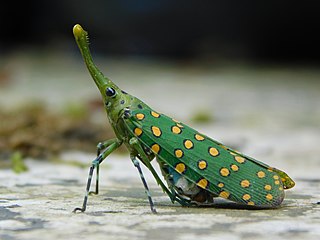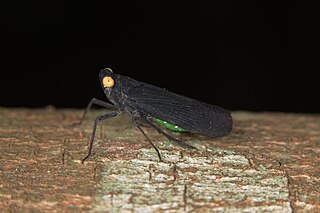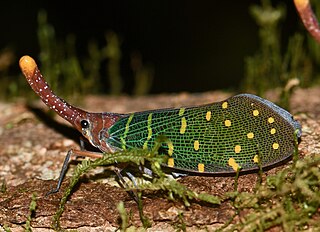
Ancyra is a small genus of planthoppers of the family Eurybrachidae and the only genus in the tribe Ancyrini. Species in this genus occur in southeast Asia.

Saiva is a genus of Asian planthoppers, family Fulgoridae. They are colourful insects, marked boldly in red, blue, white and black, with a prominent slender stalk like structure arising on the head that points upwards or forward. The known distribution is from India, through Indo-China to Borneo.

The fulgorid genus Fulgora contains several large Central and South American planthoppers known by a large variety of common names including lantern fly, peanut bug, peanut-headed lanternfly, alligator bug, machaca, and jequitiranaboia.

Pyrops is a genus of planthoppers that occur primarily in southeast Asia, containing about 70 species. They are fairly large insects, with much of the length due to an elongated, upcurving, snout-like projection of the head. The wings are generally brightly patterned in contrasting colors, and they are popular among collectors.

The subfamily Aphaeninae is a group of hemipteran insects, especially abundant and diverse in the tropics. They belong to the Fulgoridae (fulgorids), though they are not among the better-known members of that family that are called "lantern bugs" or "lanternflies". In 2009, the first molecular analysis of the Fulgoridae challenged the existing structure of eight currently recognized subfamilies and eleven tribes.

Issidae is a family of planthoppers described by Spinola in 1839, belonging to the order Hemiptera, suborder Auchenorrhyncha superfamily Fulgoroidea.

Lophopidae is a family of fulgoroid plant-hoppers with most species found in tropical South America and Asia.

Gergithus is a genus of tropical Asian planthoppers in the family Issidae, erected by Carl Stål in 1870. Like all planthoppers, adults feed on plant sap and are capable of escaping by leaping. The genus like other members in the tribe appears somewhat rounded and beetle-like, in some cases, with a mimetic resemblance to ladybird beetles. Species are mostly distributed in the Indomalayan Realm.
The Elicini are a tribe of planthoppers in the family Tropiduchidae. The type genus is Elica.

Elicinae is a subfamily of tropiduchid planthoppers in the family Tropiduchidae, with Elica the type genus.

Desudaba is a genus of bugs in the family Fulgoridae, tribe Poiocerini and subtribe Calyptoproctina Metcalf, 1938. Records are from Australia and New Guinea.

Pyrops intricatus is a species of lantern bug, an insect in the family Fulgoridae, found in Borneo. It was originally described in 1857 by Francis Walker as Hotinus intricatus.
Pyrilla is a genus of bugs in the subfamily Lophopinae and tribe Lophopini.

Hemisphaerius is a genus of bugs in the family Issidae and tribe Hemisphaeriini. Species resemble the closely related Gergithus: but are differentiated in this genus by the size of the frons and shorter legs.

Eurybrachys is a genus of bugs in the family Eurybrachidae. First formally named in 1834 by French entomologist Félix Édouard Guérin-Méneville, Eurybrachys is the type genus of the family Eurybrachidae. The spelling Eurybrachis, by the author, is considered an unaccepted orthographic variant. Species in this genus occur in Asia.

Pochazia is a genus of true bugs belonging to the family Ricaniidae.
Tropiduchus is a genus of planthoppers, recorded from Africa and Malesia.
Flata is the type genus of planthoppers in the family Flatidae and tribe Flatini, erected by Johan Christian Fabricius in 1798. Species are recorded from subtropical and tropical Asia including India, China, Indochina and Malesia.
Platybrachys is a genus of Australian Fulgoromorph planthoppers within the family Eurybrachidae.
Mnemosyne is a genus of planthoppers in the subfamily Cixiinae, erected by Carl Stål in 1866; it is the only extant type genus of the tribe Mnemosynini. Species are recorded from: South America, Africa, the Indian subcontinent, SE Asia and Australia.













